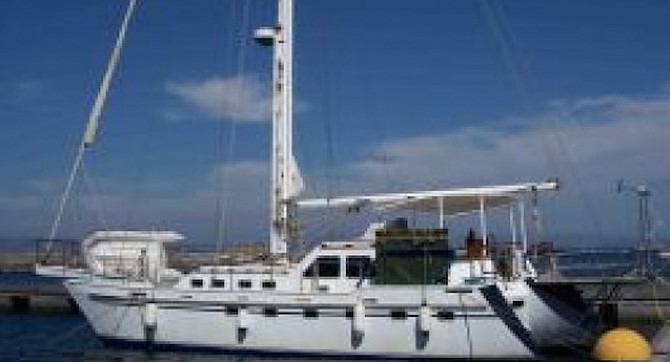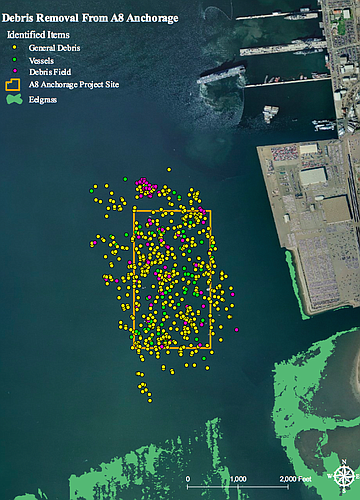 Facebook
Facebook
 X
X
 Instagram
Instagram
 TikTok
TikTok
 Youtube
Youtube

The no-man's-land of east of the jetty jutting off Zuniga Point, where people anchor for free, may be a boon to broke boaters, but for Naval Base Coronado North Island, it's a source of expensive irritation.

"We expect to find boats washed up here after every storm," said base spokeswoman Sandy DeMunnik. "The American taxpayers end up paying for us to remove them."
In the 17 months since January 2016, 31 boats have washed up on the sands between the dog beach and the northern tip of the base. It seems like they stay there for a while, including the sailboat currently marking the sandy shore at the southerly end of the beach. It came ashore on May 6, about the same time that another vessel washed up in front of the Hotel Del Coronado. "Regulations say we have to notify the owner and give him 30 days to respond," she explains. "More often than not, we can't find the owner because the hull number is illegible or just not there."

Zuniga Point and the jetty are at the tip of Coronado, where San Diego Bay meets the ocean. The jetty sticks out south about a mile from the point and is partly submerged, depending on tides. It has its own song, composed by Eric Lamb. (He also wrote songs for Shelter Island and Glorietta Bay.)

It was built by the federal government over a period of 11 years, starting in April 1893 in an attempt to stop the ocean current from bringing sand into the bay. (The feds built a railroad to Coronado to haul the boulders, according to the city's tourism site.)
The Port shut down the last free anchorage in the bay in 2006, according to grant applications with the National Marine Fisheries. After it was closed, this area near the jetty became a clean-up headache; Port contractors have pulled out tons of garbage ranging from scuttled ships to washing machines.
After that, the east side of the jetty became a pirate anchorage for people who didn't want to or couldn't pay anchorage fees. They could anchor there and oar or motor into the bay in dingies, according to Port officials.
"It's not really a mooring area," said Harbor Police Chief John Bolduc. "It's unregulated because no one's authority applies there — not the Port's, nor the Navy's or the city or the Coast Guard." Sometimes, there are lots of boats and sometimes there are none, he said.
"If someone wants to anchor and they don't have the means to go somewhere to pay for it, they head there. Or if their boat has failed inspection or isn't registered," he said.
The Alaskan Star was such a boat. The "fishing barge" was anchored there for a couple of years, ending in 2014. The owner, Johny Jones, who goes by Capt. Anthony, said he was driven away by pirates and Harbor Police. Until he left, Jones ran a fish-and-party barge, where for $25 a day, people could come out and fish and apparently get near great white sharks that Jones was chumming to attract. About a half dozen testimonials mark his web page, now abandoned.
Jones said he is from Alaska and when he retired, he dreamed of living on a boat in San Diego. He wouldn't say how he came to own the Alaskan Star. But he had a lot to say about the other boaters anchored at the jetty. "The pirates would stalk the jetty — get to know when you were gone, and once you were gone, they would steal the sail mast, rudder, outboard engines, or anything of value," he said. "They cut the anchor line, steal the anchor. What would happen next is your boat would run aground on the Naval base shore. It was a nightmare."
That's what happened to the Alaskan Star, he said. In fact, he lost two boats that were anchored east of the jetty. He didn't want to provide much information after that, except that he is living his dream off the coast of Santa Barbara these days.
It costs between $2,500 to $60,000 to remove one of those stranded boats from the Naval base, DeMunnik said. "We make sure they aren't leaking anything toxic and we try to get a hull number, though we often don't."
Chief Bolduc isn't surprised that identifying the owners is nearly impossible much of the time. "We think people have taken vessels that they don't want any more out there. Rather than pay for environmentally correct disposal, they strip them and leave them for the next storm," he said.
So disposal falls to the Navy, which has its own environmental issues. Part of the year on part of the base, protections for the endangered least terns can keep clean-up crews from coming in with heavy equipment, DeMunnik said. "Sometimes the boats wash ashore and then get pulled back out and broken up, and come back in as debris," she said.


The no-man's-land of east of the jetty jutting off Zuniga Point, where people anchor for free, may be a boon to broke boaters, but for Naval Base Coronado North Island, it's a source of expensive irritation.

"We expect to find boats washed up here after every storm," said base spokeswoman Sandy DeMunnik. "The American taxpayers end up paying for us to remove them."
In the 17 months since January 2016, 31 boats have washed up on the sands between the dog beach and the northern tip of the base. It seems like they stay there for a while, including the sailboat currently marking the sandy shore at the southerly end of the beach. It came ashore on May 6, about the same time that another vessel washed up in front of the Hotel Del Coronado. "Regulations say we have to notify the owner and give him 30 days to respond," she explains. "More often than not, we can't find the owner because the hull number is illegible or just not there."

Zuniga Point and the jetty are at the tip of Coronado, where San Diego Bay meets the ocean. The jetty sticks out south about a mile from the point and is partly submerged, depending on tides. It has its own song, composed by Eric Lamb. (He also wrote songs for Shelter Island and Glorietta Bay.)

It was built by the federal government over a period of 11 years, starting in April 1893 in an attempt to stop the ocean current from bringing sand into the bay. (The feds built a railroad to Coronado to haul the boulders, according to the city's tourism site.)
The Port shut down the last free anchorage in the bay in 2006, according to grant applications with the National Marine Fisheries. After it was closed, this area near the jetty became a clean-up headache; Port contractors have pulled out tons of garbage ranging from scuttled ships to washing machines.
After that, the east side of the jetty became a pirate anchorage for people who didn't want to or couldn't pay anchorage fees. They could anchor there and oar or motor into the bay in dingies, according to Port officials.
"It's not really a mooring area," said Harbor Police Chief John Bolduc. "It's unregulated because no one's authority applies there — not the Port's, nor the Navy's or the city or the Coast Guard." Sometimes, there are lots of boats and sometimes there are none, he said.
"If someone wants to anchor and they don't have the means to go somewhere to pay for it, they head there. Or if their boat has failed inspection or isn't registered," he said.
The Alaskan Star was such a boat. The "fishing barge" was anchored there for a couple of years, ending in 2014. The owner, Johny Jones, who goes by Capt. Anthony, said he was driven away by pirates and Harbor Police. Until he left, Jones ran a fish-and-party barge, where for $25 a day, people could come out and fish and apparently get near great white sharks that Jones was chumming to attract. About a half dozen testimonials mark his web page, now abandoned.
Jones said he is from Alaska and when he retired, he dreamed of living on a boat in San Diego. He wouldn't say how he came to own the Alaskan Star. But he had a lot to say about the other boaters anchored at the jetty. "The pirates would stalk the jetty — get to know when you were gone, and once you were gone, they would steal the sail mast, rudder, outboard engines, or anything of value," he said. "They cut the anchor line, steal the anchor. What would happen next is your boat would run aground on the Naval base shore. It was a nightmare."
That's what happened to the Alaskan Star, he said. In fact, he lost two boats that were anchored east of the jetty. He didn't want to provide much information after that, except that he is living his dream off the coast of Santa Barbara these days.
It costs between $2,500 to $60,000 to remove one of those stranded boats from the Naval base, DeMunnik said. "We make sure they aren't leaking anything toxic and we try to get a hull number, though we often don't."
Chief Bolduc isn't surprised that identifying the owners is nearly impossible much of the time. "We think people have taken vessels that they don't want any more out there. Rather than pay for environmentally correct disposal, they strip them and leave them for the next storm," he said.
So disposal falls to the Navy, which has its own environmental issues. Part of the year on part of the base, protections for the endangered least terns can keep clean-up crews from coming in with heavy equipment, DeMunnik said. "Sometimes the boats wash ashore and then get pulled back out and broken up, and come back in as debris," she said.
Comments